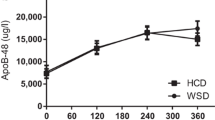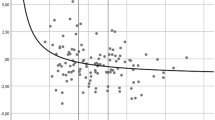Abstract
Purpose
Starting from the evidence-based health benefits that resistant starch (RS) shows when added to the diet, our aim in this study was to evaluate the effects of increased fibre intake with two different levels of RS coming from regular daily consumed foods on normalization of glycaemia within lifestyle intervention in the population with risk factors for developing diabetes.
Methods
Study included 47 overweight and obese men and women with disordered glucoregulation and dyslipidaemia, aged between 45–74, divided into RS and Fibre group. Participants were subjected to the lifestyle and dietary intervention with low-fat and high-fibre (>25 g/day) diet for 12 months and were offered two different dietary advices aimed at increasing total fibre intake in Fibre group and at increasing RS intake in RS group.
Results
The intake of macronutrients and total fibre was similar between groups at the end of the study, but achieved RS intake was two times higher in the RS group. Decrease in total cholesterol and non-HDL-cholesterol was more pronounced in RS group in comparison with Fibre group (p = 0.010, p = 0.031, respectively), whereas in Fibre group, a more pronounced effect on glucoregulation was observed: significant fall in glycaemia after 2-h oral glucose tolerance test (7.93 vs 6.96 mmol/L, p = 0.034).
Conclusion
At the end of the study, RS-rich diet failed to affect glycaemic control in prediabetic obese individuals in contrast to the regular fibre-rich diet, which indicated that fibre profile could be an important determinant of the effect of dietary intervention.
Similar content being viewed by others
References
Alberti KGMM, Zimmet P, Shaw J (2007) International diabetes federation: a consensus on type 2 diabetes prevention. Diabet Med 24:451–463. doi:10.1111/j.1464-5491.2007.02157.x
Maggio CA, Pi-Sunyer FX (2003) Obesity and type 2 diabetes. Endocrinol Metab Clin N Am 32:805–822. doi:10.1016/S0889-8529(03)00071-9
Pi-Sunyer X, Blackburn G, Brancati LF et al (2007) Reduction in weight and cardiovascular disease risk factors in individuals with type 2 diabetes: one-year results of the look AHEAD trial. Diabetes Care 30:1374–1383. doi:10.2337/dc07-0048
Tuomilehto J, Lindstrom J, Eriksson JG et al (2001) Prevention of type 2 diabetes mellitus by changes in lifestyle among subjects with impaired glucose tolerance. N Engl J Med 344:1343–1350. doi:10.1056/NEJM200105033441801
Knowler WC, Barrett-Connor E, Fowler SE, Hamman RF, Lachin JM, Walker EA, Nathan DM, Diabetes Prevention Program Research Group (2002) Reduction in the incidence of type 2 diabetes with lifestyle intervention or metformin. N Engl J Med 346:393–403. doi:10.1056/NEJMoa012512
Penn L, White M, Oldroyd J, Walker M, Alberti K, Mathers JC (2009) Prevention of type 2 diabetes in adults with impaired glucose tolerance: the European diabetes prevention RCT in Newcastle upon Tyne, UK. BMC Public Health 9:342. doi:10.1186/1471-2458-9-342
Kontogianni MD, Liatis S, Grammatikou S, Perrea D, Katsilambros N, Makrilakis K (2012) Changes in dietary habits and their association with metabolic markers after a non-intensive, community-based lifestyle intervention to prevent type 2 diabetes, in Greece. The DEPLAN study. Diabetes Res Clin Pract 95:207–214. doi:10.1016/j.diabres.2011.09.010
Evert AB, Boucher JL, Cypress M, Dunbar SA, Franz MJ, Mayer-Davis EJ, Neumiller JJ, Nwankwo R, Verdi CL, Urbanski P, Yancy WS (2013) Nutrition therapy recommendations for the management of adults with diabetes. Diabetes Care 36:3821–3842. doi:10.2337/dc13-2042
American Association of Cereal Chemists (2001) The definition of dietary fiber. Report of the Dietary Fiber Definition Committee to the Board of Directors of the American Association of Cereal Chemists. Cereal Food World 46:112–126
Lattimer MJ, Haub DM (2010) Effects of dietary fiber and its components on metabolic health. Nutrients 2:1266–1289. doi:10.3390/nu2121266
Ulmius M, Johansson A, Onning G (2009) The influence of dietary fibre source and gender on the postprandial glucose and lipid response in healthy subjects. Eur J Nutr 48:395–402. doi:10.1007/s00394-009-0026-x
Brighenti F (2007) Dietary fructans and serum triacylglycerols: a meta-analysis of randomized controlled trials. J Nutr 137:2552S–2556S
Maki KC, Pelkman CL, Finocchiaro ET, Kelley KM, Lawless AL, Schild AL, Rains TM (2012) Resistant starch from high-amylose maize increases insulin sensitivity in overweight and obese men. J Nutr 142:717–723. doi:10.3945/jn.111.152975
Sajilata MG, Singhal RS, Kulkarni PR (2006) Resistant starch—a review. Compr Rev Food Sci Food Saf 5:1–17. doi:10.1111/j.1541-4337.2006.tb00076.x
Lindstrom J, Absetz P, Hemio K, Peltomaki P, Peltonen M (2010) Reducing the risk of type 2 diabetes with nutrition and physical activity—efficacy and implementation of lifestyle interventions in Finland. Public Health Nutr 13:993–999. doi:10.1017/S1368980010000960
World Health Organization (1999) Definition, diagnosis and classification of diabetes mellitus and its complications. Report of a WHO consultation. Part 1: diagnosis and classification of diabetes mellitus. Geneva. WHO Department of Non communicable Disease Surveillance. WHO/NCD/NCS/99.2
Dimitrijevic-Sreckovic V (2007) Adequate nutrition principles for the prevention of chronic diseases. Food and Nutr (Belgrade) 4:22–31
Marphy MM, Douglass JS, Birkett A (2008) Resistant starch intakes in the United States. J Am Diet Assoc 108:67–78. doi:10.1016/j.jada.2007.10.012
Dodevska MS, Djordjevic BI, Sobajic SS, Miletic ID, Djordjevic PB, Dimitrijevic-Sreckovic VS (2013) Characterisation of dietary fibre components in cereals and legumes used in Serbian diet. Food Chem 141(3):1624–1629. doi:10.1016/j.foodchem.2013.05.078
Friedewald WT, Levy RI, Fredrickson DS (1972) Estimation of the concentration of low-density lipoprotein cholesterol in plasma, without use of the preparative ultracentrifuge. Clin Chem 18:499–502
Matthews DR, Hosker JP, Rudenski AS, Naylor BA, Treacher DF, Turner RC (1985) Homeostasis model assessment: insulin resistance and beta-cell function from fasting plasma glucose and insulin concentrations in man. Diabetologia 28:412–419
Rave K, Roggen K, Dellweg S et al (2007) Improvement of insulin resistance after diet with a whole-grain based dietary product: results of a randomized, controlled cross-over study in obese subjects with elevated fasting blood glucose. Br J Nutr 98:929–936. doi:10.1017/S0007114507749267
Pan XR, Li GW, Hu YH et al (1997) Effects of diet and exercise in preventing NIDDM in people with impaired glucose tolerance. The Da Qing IGT and diabetes study. Diabetes Care 20:537–544. doi:10.2337/diacare.20.4.537
Kendall CWC, Esfahani A, Sanders LM, Potter SM, Vidgen E (2010) The effect of a pre-load meal containing resistant starch on spontaneous food intake and glucose and insulin responses. J Food Technol 8:67–73. doi:10.3923/jftech.2010.67.73
Landon S, Colyer CGB, Salman H (2013) The resistant starch report: an Australian update on health benefits, measurement and dietary intakes http://foodaust.com.au/wpcontent/uploads/2012/04/Hi_Maizesupplement_web.pdf Accessed March 2013
Djukic N, Sobajic S, Djordjevic B, Miletic I, Gajic I (2009) Dietary fiber intake of adolescents living in a boarding school in north-eastern part of Serbia: comparison of analyzed and calculated values. Int J Food Sci Nutr 60:14–22. doi:10.1080/09637480802241634
Gibson GR, Probert HM, Loo JV, Rastall RA, Roberfroid MB (2004) Dietary modulation of the human colonic microbiota: updating the concept of prebiotics. Nutr Res Rev 17:259–275. doi:10.1079/NRR200479
Behall KM, Hallfrisch J (2002) Plasma glucose and insulin reduction after consumption of breads varying in amylose content. Eur J Clin Nutr 56:913–920. doi:10.1038/sj.ejcn.1601411
Li M, Piao JH, Tian Y, Li WD, Li KJ, Yang XG (2010) Postprandial glycaemic and insulinaemic responses to GM-resistant starch-enriched rice and the production of fermentation-related H2 in healthy Chinese adults. Br J Nutr 103:1029–1034. doi:10.1017/S0007114509992820
Anderson JW, Story L, Sieling B, Chen WL (1984) Hypocholesterolemic effects of high-fibre diets rich in watersoluble plant fibres. J Can Diet Assoc 45:140–149
Martinez-Flores HE, Chang Yoon Kil, Martinez-Bustos F, Sgarbieri V (2004) Effect of high fiber products on blood lipids and lipoproteins in hamsters. Nutr Res 24(1):85–93. doi:10.1016/j.nutres.2003.08.016
Kerckhoffs DA, Hornstra G, Mensink RP (2003) Cholesterol-lowering effect of beta-glucan from oat bran in mildly hypercholesterolemic subjects may decrease when beta-glucan is incorporated into bread and cookies. Am J Clin Nutr 78:221–227
Maki KC, Davidson MH, Malik KC, Albrecht HH, O’Mullane J, Daggy BP (1999) Cholesterol lowering with high-viscosity hydroxypropylmethylcellulose. Am J Cardiol 84:1198–1203. doi:10.1016/s0002-9149(99)00534-2
Slavin J (2013) Fiber and prebiotics: mechanisms and Health benefits. Nutrients 5:1417–1435. doi:10.3390/nu5041417
Acknowledgments
This study was financed by the grant from the Serbian Ministry of Education and Science and Technology Development (III46001). We would like to thank our colleague Prof. Natasa Bogavac Stanojevic for the help in performing part of the statistical analysis.
Conflict of interest
All authors had no potential conflict of interest to declare in relation with the content of this article. None of the sponsors had any role in defining the study design or its implementation or in data analysis and interpretation.
Author information
Authors and Affiliations
Corresponding author
Rights and permissions
About this article
Cite this article
Dodevska, M.S., Sobajic, S.S., Djordjevic, P.B. et al. Effects of total fibre or resistant starch-rich diets within lifestyle intervention in obese prediabetic adults. Eur J Nutr 55, 127–137 (2016). https://doi.org/10.1007/s00394-015-0831-3
Received:
Accepted:
Published:
Issue Date:
DOI: https://doi.org/10.1007/s00394-015-0831-3




